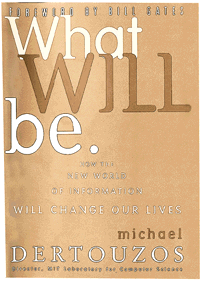What Will Be: How the New World of Information Will Change Our Lives by Michael Dertouzos
What Will Be: How the New World of Information Will Change Our Lives by Michael Dertouzos (336 pages, HarperCollins, 1997)
(originally published by Booz & Company)Most of the recent books on the coming digital age, now weighing heavily on remainder tables all over the land, are divided into two visions of the future: one represented by George and Jane Jetson and one represented by H.G. Wells.
The Jetson future, like the Jetsons themselves, is cartoonish — optimistic and enthusiastic, with a 1950's vision of technology at work making life more convenient and entertaining for humans. The gag is that it's several centuries hence, but social relations are precisely the same as in the 20th century — indeed, the same as in the dinosaur-era "Flintstones," which preceded "The Jetsons" out of the Hanna-Barbera production shop. George has a never-satisfied boss, a spunky wife, two self-involved children and a wisecracking maid. Technology changes, the cartoon's creators seemed to believe, but human nature does not.
 The Wellsian future was a far darker place. Though Wells was a passionate advocate of technology and the good it could do to right society's wrongs, he saw clearly that it had the power to transform social relationships and to unleash forces that would not be controlled. By the end of his life, he had lost faith in humanity's ability to adapt to changes forged by science.
The Wellsian future was a far darker place. Though Wells was a passionate advocate of technology and the good it could do to right society's wrongs, he saw clearly that it had the power to transform social relationships and to unleash forces that would not be controlled. By the end of his life, he had lost faith in humanity's ability to adapt to changes forged by science.
It is no small compliment to say that Michael Dertouzos' new book, What Will Be: How the New World of
Information Will Change Our Lives, combines the best of the Jetsons' cheerful optimism with Wells's perspicuous concern for the fate of humanity.
Mr. Dertouzos, head of the Laboratory for Computer Science at the Massachusetts Institute of Technology, is enthusiastic about the possibilities of the digital future, and spends much of the book surveying the impact advances in technology are likely to have on our work, leisure and family lives over the next century. The merger of interactive computer technology and improved telecommunications, he argues, has the potential to lead to social change as momentous as that wrought by the Industrial Revolution.
Yet he is mindful that revolutions tend to have winners and losers. Inevitably, the Information Revolution will dislocate and supersede some people, and it will surely widen the gap between the wired industrialized economies and the unwired developing economies.
Mr. Dertouzos reminds us that the invention of the steam engine in the mid-18th century was the beginning of a wave of technological innovation that lasted for 150 years. The impact of the steam engine alone was pervasive: it made possible railroads and factories, which in turn transformed transportation, food production and work arrangements. New machinery supported huge leaps in productivity and output and ultimately much improved standards of living for those in the industrializing world who were able to benefit.
The technology of the Industrial Revolution in effect reduced distances and saved time. It made trade over previously insurmountable geography economical. It allowed people more mobility.
Mr. Dertouzos thinks computers and telecommunications will have the same effect. "What would people do if they all had computers and all these computers were interconnected?" he asks. He envisions what he has been calling, for almost 20 years, an "information marketplace" — a central meeting place, much like the cheerfully anarchic flea markets of his boyhood in Athens, where people met to exchange goods, services and conversation. The difference is, people will meet on line, as they do now in chat rooms and bulletin boards, and on a much broader scale. As the technology improves, as it inevitably must, electronic communication will grow more sophisticated. We will gain an "electronic proximity" that will increase by many factors our interactions with others.
Some of what Mr. Dertouzos envisions is already here, if only in rudimentary form. Computers with voice-recognition technology can translate spoken language into text. Virtual reality can put us in the middle of a space battle or at the top of a ski slope we would never try in real life. The Jetson in Mr. Dertouzos gleefully conjures up a future in which we will be able to ring up our kitchens and tell them to get dinner ready or convene a multimedia conference call with family members scattered around the globe. The primitive virtual-reality data gloves of today will evolve into bodysuits that can sense touch remotely. We may be able to sit down at a piano, for example, cue up a sensory experience cartridge and enjoy a "hands on" lesson, guided via the bodysuit by a concert pianist.
However much he enjoys it, the gadgetization of daily life is not Mr. Dertouzos' only goal. Electronic proximity has the power to break down national and tribal boundaries, perhaps even casting a kind of giant bodysuit over the world: a scrim of unity that brings people together but does not obliterate the differences that make them interesting. He believes that, despite the current evidence that computers have not improved white-collar productivity, they will eventually. He also provides a comprehensible introduction to the science that underlies telecommunications for those who want to dip a toe in. And he explores at some length the implications of the new technology for commerce and government.
It would be interesting to know more about what Mr. Dertouzos thinks the Information Revolution means for democracy — a topic he passes over with a couple of sentences. The world is becoming increasingly wired just as people seem to be losing faith in the ability of government to maintain its side of the social contract. The success of market reform in some economies has undermined the determination of governments to correct the excesses of capitalism. Mr. Dertouzos worries about the widening gap between rich and poor; these days most socioeconomic trends, like market reform, seem to widen that gap. Is the gap inevitable? How might the new technology be used to narrow it?
The main gap Mr. Dertouzos is interested in is the one between humanists and techies: those who see electronic science as unemotional and dehumanizing and those who fiercely believe that computers and telecommunications are the digital representation of reason.
Mr. Dertouzos reframes this old dichotomy in the language of the new technology and takes the centrist position: reason and technology enhance, not oppose, feelings and human connections. Technology is fun and spiritual, amusing and unifying. It is, in short, the perfect synthesis of Jetson and Wells. ![]()


